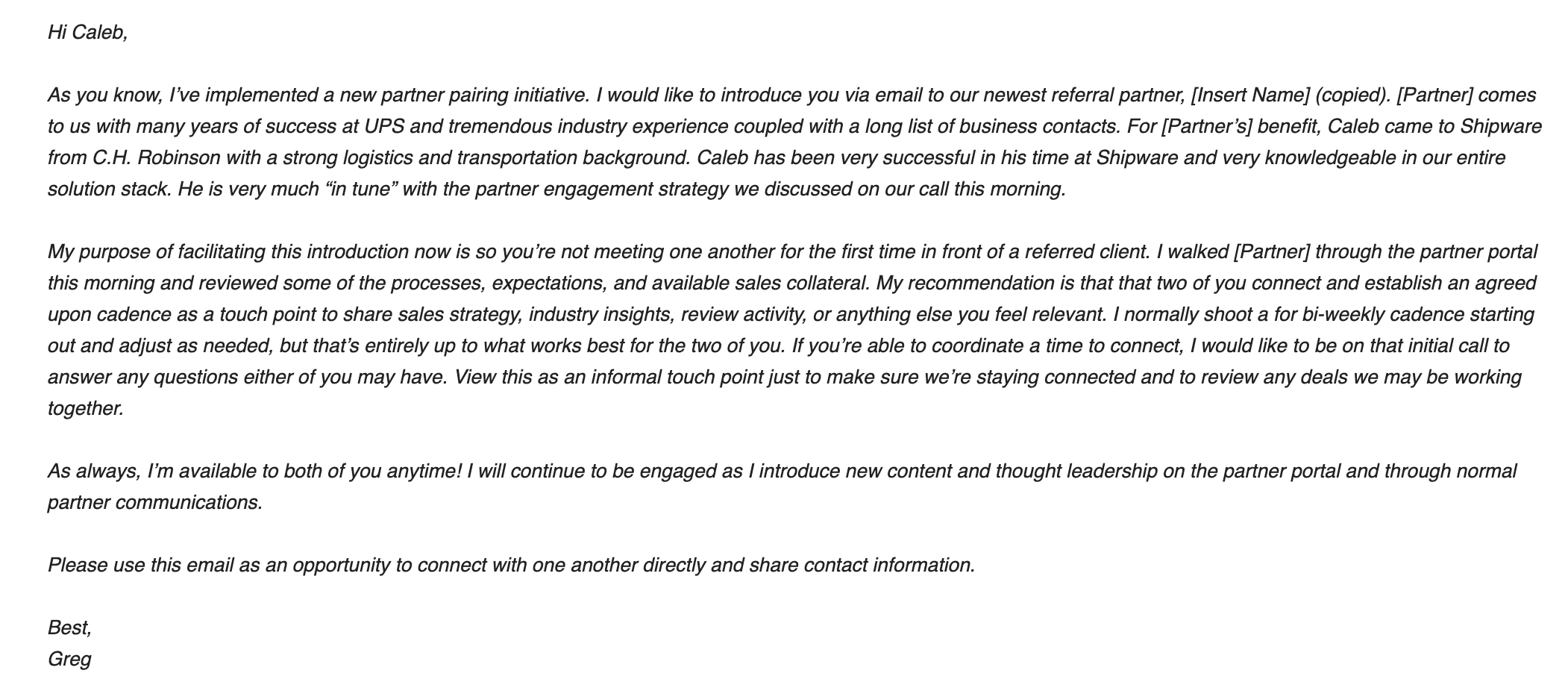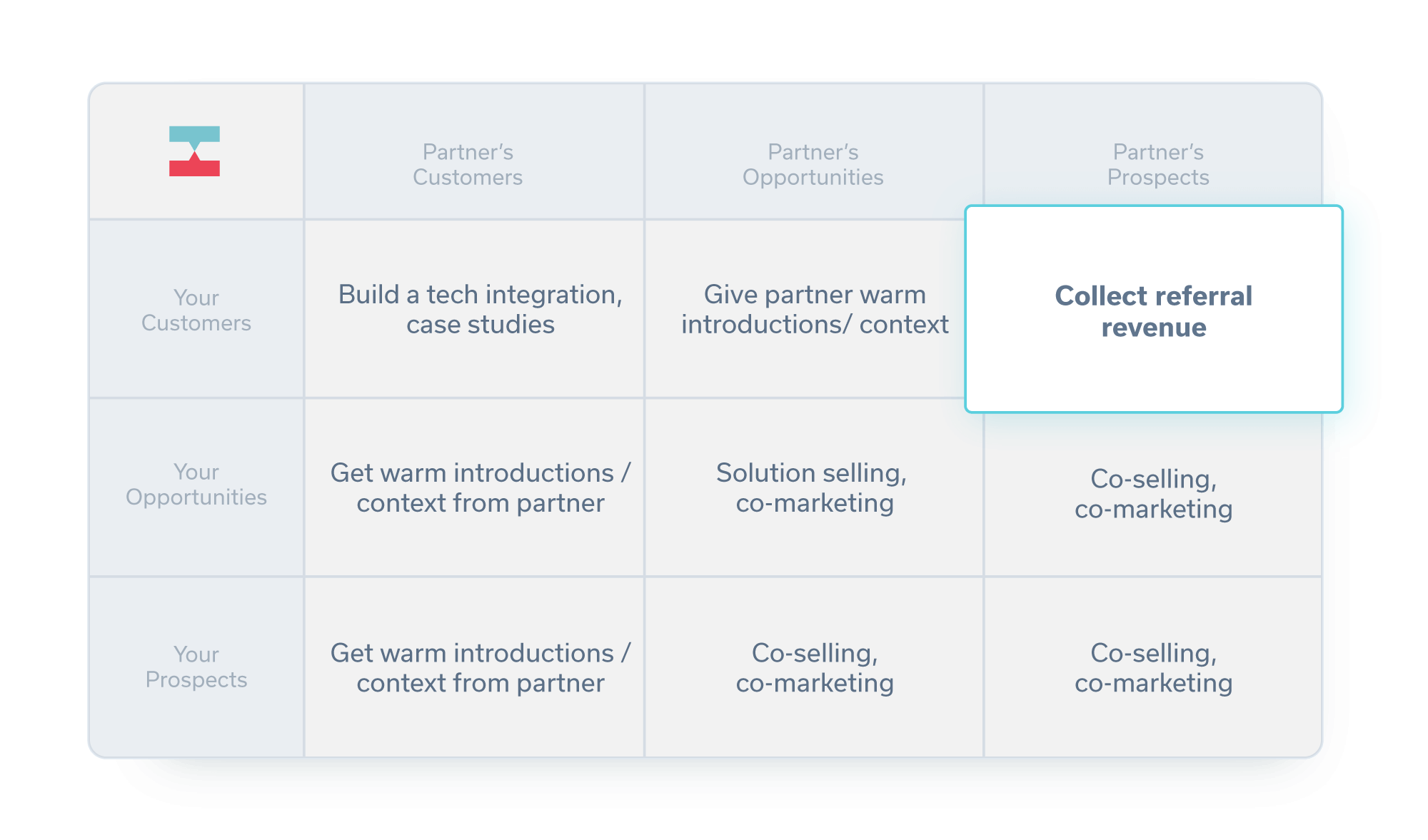Picture this:
You reach out to your partner asking why they haven’t sent you any EQLs, and they ask you why you never say, ‘How are you?’ (rude!).
Your partner’s sales rep brings new opportunities to your rep every week, but your rep hasn’t returned the favor.
Your marketing team hands off a bunch of co-marketing responsibilities to your partner’s team, and your partner’s left wondering why they’re pulling all the weight.
All of the above scenarios are signs of an unbalanced partnership — one side is putting in more effort than the other. If you’re not careful, this could lead to some complicated conversations when it comes time to renew the partnership. In this article, we’re exploring eight ways to ensure your partnerships are mutually beneficial so everybody’s excited to keep the EQLs flowing. Or, if you have a partnership that’s already lost its way, these tactics can help you put sore feelings in the past and start anew.
1. Call/message your partner just to check in
Not everything needs to be about business. You need to nurture a long-term, successful relationship with your partner. Why not make a friend along the way? The more often the two of you check in, the more likely you’ll have conversations like, “By the way, my customer’s looking for new software in your space. Kinda perfect you reached out to me today!”
Diane Schmidt, Vice President of Partner Development at Optimizely, says, “We have about 150 partners in North America and I try to speak with at least 50 of them every month.” Sometimes these casual check-ins lead to business, like when one call led to a new joint marketing campaign and produced a referral for a new license sale.
“It’s important to maintain the pulse of what’s going on with our partners,” says Schmidt.
2. Book recurring co-selling syncs with your partner
Set expectations early for when and how you or your sales reps will check in with your partner’s team. You can even bake the specifics of your co-selling check-ins, including your preferred cadence, into your partnership agreement.
A few examples of co-selling cadences we’ve seen work:
The 2-2-2-2 meeting. Every two weeks, you bring two leads for your partner, your partner brings two leads for you, and then you identify two accounts you can sell your joint solution to.
X per quarter. You or your sales rep should have a goal to reach out to your partner for co-selling a specific number of times each quarter. Keep the number low at first, and then increase the goal as your team grows and can handle a more rapid cadence or throwing more partners into the mix.
Workflow automation. If you’re using a partner ecosystem platform (PEP) like Crossbeam, you can set up automatic alerts to fire in Slack every time a new overlap is found. These alerts can serve as signals that it’s time to kick off your co-selling!
Greg Unruh, Director of Partner Strategy and Channel Sales at Shipware and Consultant at Partnernomics, says he uses role-based partner pairings to match his outbound sales reps with sales reps at his partner’s company. Each sales rep checks in with their partners to discuss shared target accounts biweekly. If the partner rep is unengaged, Unruh’s reps can score the partner rep appropriately to get a replacement pairing.

An example email to a partner kicking off a new partner pairing. Image courtesy of Shipware.
3. Ask questions that will help you stay knowledgeable about your partner’s products
You’re going to speak on behalf of your partner in a variety of situations — whether you’re selling your partner’s product to a target account, you’re pitching their product to an existing customer, or you’re making an intro for your partner and want the email to sound really, really good.
Tyler Meckes, Account Manager at Connection, makes sure to ask partners about their latest product updates, industry trends, and changes in the competitive landscape. In fact, Meckes co-hosts a podcast called TechSperience, where he recently interviewed Logitech’s Bob Knepp and Jen Jakubowicz about how the company known for its mouse and keyboards expanded into the conference space. Check out the episode, “A Cure for the Conference Room Blues.”
Meckes then uses his newfound knowledge about the partner’s products and their industry at large to serve as a consultative resource to his customers.
“I’m providing value for the customer by saying, ‘Did you know this bit of industry knowledge?’” says Meckes. “In asking that question, I’m also getting information back that I could leverage later on.”
Meckes references learnings about his partner’s product or industry to educate the customer about the latest use cases for particular products and provide tech stack recommendations. His customer’s response to the newfound information can inform which use cases and innovations are most relevant for sharing with additional customers who have similar business needs. The conversation can also open the door for Meckes to make an introduction between the customer and his partner.
4. Pay attention to your partner’s competitors in the news (and offer a hand when your partner needs it!)
Throwing your partner a life line will make your partner’s day. If you catch your partner’s competitor just announced a new round of funding or a new feature launch, ask your partner how you can help them stay top of mind with their targets and close the deals they have in the works.
You can help provide the competitive edge they need in a pinch, and your thoughtfulness will go a long way. You’ll stay top of mind for your partner, and they’ll be more likely to pitch your product casually in conversations with target accounts and customers.
5. Send leads to your partner (just because you can)
Want to make a really good impression? Identify areas in your conversations with customers to put in a good word for your partner. If mentioning your partner piques your customer’s interest, ask the partner if they’d like an intro. They’ll probably respond with a, “Hell, yes!”
Before your co-selling sync, map accounts with your partner to identify which of your customers overlap with your partner’s target accounts. You and your partner might already be meeting to touch base about a handful of overlapping accounts, but give them something more. Show them how you can help them reach additional leads and accelerate more deals than they came to the meeting expecting.

Keep the momentum going, and your partner may very well come to your next sync bearing ecosystem qualified leads (EQLs), too!
6. Keep your partner in the loop on your joint customers’ needs
Don’t keep your partner too far at bay. If it’s your team’s job to serve as practitioners for the customer on behalf of your partner, keep your partner informed on the most critical pieces of information they need to know.
There’s two big reasons this will keep your partner happy:
- Your partner (or the partner rep your sales rep is working with) reports to their higher up. Give them the answers they need to look good for their boss — everything from when the deal is expected to close, to the customer’s pain points, to their future plans for using the product. Don’t keep your partner in the dark.
- Your partner’s always going to know their own product better than you (or your team). There’s always going to be a new feature coming out or a new
enablement course that you haven’t gotten around to completing. Keep your partner informed about your customer’s use cases for using the partner’s product, their pain points, and their business goals. It’s better to involve your partner earlier than to have them react and fix a major problem — one that could result in the customer churning, nonetheless!
7. Delineate responsibilities across both your teams to make sure no one’s carrying all of the weight
Don’t rely solely on your marketing team to identify who’s doing what on their call with your partner’s team. Your marketing team could get stuck with all the work (or vice versa), and neither team will be excited to create and launch your go-to-market (GTM) campaign.
“I often start off by saying ‘Let’s swap some social media posts’,” says Brian Jambor, Head of Partnerships at Sendoso. “Juxtapose that with a webinar. Pulling that off is much more complicated. Who should you invite? How many marketing emails should you send? Who is running the ads? Are we doing retargeting? Who is creating the slide decks? What platform are we using? It’s such a heavy lift. We have to have someone that has a ton of prospect alignment with us to do that.”
A few pieces of advice:
Use a term sheet to make sure each team at your partner’s org is bought into partnerships and is ready to carry their side of the weight. The term sheet can include information like which teams and stakeholders will contribute to a specific GTM and how often your campaign strategy should be revisited.
If you’re passing the co-selling motion on to your sales reps, make sure each rep fills you in on their solution-selling game plan. You can provide additional support by brokering meetings between your reps and your marketing team to map out the co-selling collateral each rep will need and when. This will help you avoid teams on either side of the partnership scrambling to make their deadlines.
Adopt partnerships-related key performance indicators (KPIs) and objectives and key results (OKRs) for every team in your organization. Determine your goals for the year out ahead of your strategic planning meetings; then, discuss exactly what you need from each team to get the results you’re trying to achieve.
8. Don’t be shy, tell your partners what you need!
Your partners can’t read your mind, but they can give you EQLs if you ask for them. Don’t always expect your partners to give, give, give 100% of the time without you asking first. Be direct.
It could be as simple as, “Hey, got any customer shopping around for X?” or “I’m targeting more strategic accounts in X region. Could we map accounts real quick to see what overlaps we have and then pass them onto our reps?”
“I’ve had partners say ‘Hey you keep asking and we don’t get anything in return!” says Jambor. “So then I say ‘But you never ask for anything! I’ll give you all sorts of referrals, just ask for them!’”
—
Do you have a rule you live by to ensure all of your partnerships are mutually beneficial? Let us know @Crossbeam.



